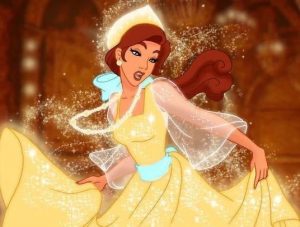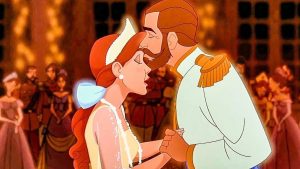Anastasia (1997)

Anastasia (1997), directed by Don Bluth and Gary Goldman, is an animated musical that takes creative liberties with the story of the Romanov family and the tragic fate of Grand Duchess Anastasia Nikolaevna of Russia. While it is not an entirely historical retelling, the film successfully combines history, fantasy, romance, and adventure, making it a timeless classic in the realm of animated films.
Suggested videos for you:
Plot and Characters
The film opens with a tragic event—the 1918 execution of the Russian royal family by Bolshevik forces. The youngest daughter, Anastasia, narrowly escapes but suffers amnesia and grows up as an orphan in St. Petersburg. Fifteen years later, the young woman, now known as Anya (voiced by Meg Ryan), embarks on a quest to discover her true identity. Along the way, she is befriended by Dmitri (John Cusack), a former servant of the royal family who has joined forces with the ambitious and loyal Vlad (Kelsey Grammer) to find the lost princess and claim the reward promised by the Dowager Empress Marie (Angela Lansbury).
The film cleverly plays on the notion of the lost princess, blending elements of mystery and adventure as Anya, Dmitri, and Vlad travel from Russia to Paris, evading the vengeful Rasputin (Christopher Lloyd), who cursed the Romanov family in a desperate bid for power. The search for Anya’s true identity becomes intertwined with the mystery of Rasputin’s evil plot, which forms the central antagonist of the film.
Anya’s gradual realization of her royal past provides much of the emotional depth of the story, especially as she grapples with her memories and sense of belonging. The relationship between Anya and Dmitri evolves from wary allies to romantic partners, creating a compelling and tender love story. Dmitri himself is an interesting character—a man who is both charming and emotionally scarred, which gives him a complexity not typically seen in animated romantic leads. His transition from a cynical con man to a loyal hero is one of the film’s more satisfying arcs.
Rasputin, voiced by Christopher Lloyd, is the film’s main antagonist, though his supernatural nature and villainous motivations are entirely fictionalized. He is a deeply exaggerated character, a dark sorcerer who seeks to exact revenge on the Romanovs by cursing their family, but his character provides a certain macabre energy to the film, even if he feels out of place in a story that otherwise maintains a somewhat grounded tone.
Animation and Visuals
The animation in Anastasia is one of its most striking features. The film’s visual style is lush, rich, and cinematic, blending traditional 2D animation with some early CGI techniques that were innovative for the time. The character designs are elegant, and the backgrounds—particularly the opulent settings of Russia and Paris—are vibrant and intricate. The film’s use of color, light, and shadow adds to the overall mood, with darker tones highlighting the ominous presence of Rasputin and brighter hues conveying the hopeful, romantic elements of the narrative.
One of the standout sequences is the grand ballroom dance scene set to “Once Upon a December.” The animation here is breathtaking, with the flowing gowns and swirling waltzes creating a dreamlike quality. The attention to detail in the set designs, particularly the grand palace interiors and Parisian landmarks, helps immerse the audience in the world of Anastasia, creating an atmosphere of mystery and wonder.
Music and Songs
The musical score for Anastasia, composed by Lynn Ahrens and Stephen Flaherty, is a key element that elevates the film. The songs are catchy, emotional, and expertly integrated into the narrative. “Journey to the Past” is a powerful opening number that captures Anya’s longing for her lost heritage, and its optimism resonates throughout the film. The hauntingly beautiful “Once Upon a December” serves as a nostalgic reflection on the lost grandeur of the Romanov family, while also showcasing the emotional depth of Anya’s journey to reclaim her past.
The score also includes several energetic and lively songs, like “A Rumor in St. Petersburg” and “In the Dark of the Night,” which feature memorable lyrics and sweeping melodies. These songs offer contrast to the more somber moments and help maintain a lively pace throughout the film. Even though the songs lean more toward the Broadway-style musical format rather than traditional Disney-esque ballads, they fit perfectly with the tone and themes of the film.
Themes and Tone
Anastasia tackles themes of identity, belonging, and the search for family, all while blending elements of history and myth. The search for Anya’s true identity provides a powerful emotional core, as she slowly uncovers the truth about her past while also discovering her own strength and resilience. The film’s portrayal of family—both biological and chosen—is another key theme, with Anya finding not just a family in the Romanovs but also a supportive bond with Dmitri and Vlad.
While the film is undoubtedly a romantic adventure, it also explores the themes of loss and memory. Anya’s struggle to reconcile her past with her present creates an emotional conflict that resonates with viewers of all ages. The presence of Rasputin, while exaggerated and fantastical, adds a layer of tension, and the dark magic surrounding his curse introduces an element of suspense to the otherwise straightforward historical adventure.
Despite its darker moments, the film maintains a sense of hope and optimism. The balance between lighthearted moments (like the comedic interplay between Vlad and Dmitri) and the film’s more dramatic scenes (such as Anya’s emotional reunion with the Empress) helps create a well-rounded narrative that appeals to both younger and older audiences.
Historical Inaccuracies
While Anastasia incorporates some historical elements—such as the Romanov family’s fate and the Empress’ search for her granddaughter—it takes significant liberties with the actual story. In reality, Anastasia Romanov was not believed to have survived the execution, and the mystery of her fate was a topic of speculation for decades, with numerous impostors claiming to be the lost princess. The film presents a highly romanticized and fictionalized version of events, with an entirely invented plot involving Rasputin’s curse and a fairy-tale ending. While these liberties may be seen as problematic from a historical perspective, they serve the film’s thematic and narrative needs, providing an engaging and accessible story.
Criticism
One of the major criticisms of Anastasia is the lack of historical accuracy, particularly in its depiction of Rasputin as a supernatural antagonist. This choice was made to add an element of fantasy and drama to the story, but it departs from the real-life complexity of the Romanov tragedy. Additionally, the film simplifies the political context of the Russian Revolution, focusing more on the emotional and personal journey of Anya rather than the broader historical events. Some viewers may also find the film’s portrayal of Russia and its culture a bit superficial, as it focuses more on spectacle and emotion than on portraying the real historical and social context.
Legacy
Despite its historical liberties, Anastasia has endured as a beloved animated classic. The film resonates with audiences due to its richly drawn characters, sweeping romance, stunning visuals, and memorable songs. It has gained a dedicated fanbase, particularly in the realm of animated films, and its soundtrack continues to be appreciated by fans. The film has even inspired a Broadway musical adaptation, which speaks to its lasting appeal and cultural impact.
Though it might not hold the same place in the pantheon of Disney classics, Anastasia is a standout among non-Disney animated films. Its artistic ambition, emotional depth, and timeless appeal have ensured that it remains a cherished film for audiences of all ages.
Final Thoughts
Anastasia is a beautifully crafted animated film that excels in its visual storytelling, music, and emotional depth. While its historical inaccuracies may bother purists, the film’s fantasy elements and romanticized portrayal of the lost princess have made it a classic in its own right. Through its memorable characters, enchanting songs, and captivating animation, Anastasia tells a story of loss, love, and identity that resonates deeply with audiences. It is a film that continues to captivate viewers with its timeless charm and emotional impact.











